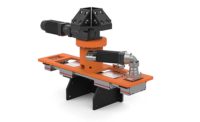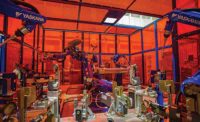Most people would agree that the proverb, “The squeaky wheel gets the grease,” is not meant to be taken literally. To them, the expression conveys the idea that the most important problems are the ones most likely to get attention. However, integrators and machine builders are not most people.
“A few years ago, an automotive manufacturer needed us to build and install an add-on grease-application station to an assembly system,” notes Edward Karabec, president and CEO of Lanco Integrated. “The station was necessary because the parts made on the original system were too-often squeaking in the car during movement.”
Karabec says add-on situations can occur when the client needs to expand the scope of its commissioned system, but can’t afford to allow for extra assembly, delivery or installation time. This situation can force integrators to build fully or semiautomated assembly systems on shorter-than-normal timelines.
“In the age of COVID-19, we’ve begun using remote and ongoing design reviews to address this problem and get the work done on time,” says Karabec. “Before, we used to have one final design review with the client coming to our facility to see the whole system in operation. Now, Microsoft Teams lets us have multiple reviews, so we can get the go-ahead on each process within the system, order and receive parts sooner and complete the project quicker.”
Lanco’s reviews are quite detailed, according to Karabec, and involve reviewing designs and CAD drawings, as well as zooming in on each system station in operation. Those in attendance include three to 10 designers and engineers from Lanco, and the same amount of quality, technical, safety people and assembly operators from the client.
“Over the past several months, we’ve completed six projects for medical-industry manufacturers using the remote reviews along with similar design, engineering and assembly components and techniques,” explains Karabec. “All of the systems are fully automated, and vary in complexity, assembly process and size, with the largest measuring 75 feet long by 30 feet wide. Most importantly, all of them were completed in eight to 18 weeks, rather than the typical timeframe of 35 weeks.”
Needing to meet shorter deadlines has become more commonplace for integrators in recent months, due to the COVID-19 pandemic. The downside of this has often been staff members working extremely long hours. But, as the following examples illustrate, designers and engineers are applying lessons learned from this experience to build a wide variety of systems quicker and better, with more flexibility and less stress.
Machine Assembles Parts for Coronavirus Test Kits
Not long after the World Health Organization declared the COVID-19 outbreak a global pandemic this past March, Lanco got an important phone call from Dutch medical company QIAGEN. The manufacturer wanted Lanco to quickly design and build an automated assembly system to produce components for coronavirus test kits.
Typically, such a project would take approximately 35 weeks, including design, engineering and manufacturing. Lanco had it ready in just eight weeks.
“When the request came in…I immediately thought, ‘This is crazy,’” says Jake Rollins, a Lanco engineer. “We can’t build a machine in eight weeks. But then my next thought was, ‘There has to be a way to do it.’”
Rollins and another engineer, David Raymond, led the project, which involved developing and building a machine that produces miniature “spin columns.” These columns are a key component in polymerase chain reaction test kits for the coronavirus.
The design phase, which would normally take five to six weeks, was completed in six days after Lanco received the order. “In the beginning, we were working seven days a week until midnight or 2 a.m. to get everything pushed through,” says Rollins.
Working remotely, the Lanco team developed processes on the fly. “For material procurement, for example, we were preordering stuff before we were typically ready to, knowing that we had to…bet on what we were going to use [so we could] receive it on time,” says Rollins.
Karabec points out that the design phase included 3D printing a part-fixture prototype, and moving the fixture on a small-loop transport system before having an operator load parts into it. This action was videotaped and shown to QIAGEN for its approval before system building could commence.
A total of 20 to 35 people then worked around the clock in two shifts to build the 60-feet-long by 15-feet-wide machine in record time. The machine was then sent to QIAGEN’s assembly plant in Germantown, MD. It features 10 automated and eight manual workstations—each with a plexiglass safety barrier—and assembles 6,000 plastic parts per hour.
“Each part measures roughly 1.25 inches high and 0.5 inch wide, and was fed manually in the initial machine, which we are in the process of updating,” notes Karabec. “This past June, QIAGEN decided to replace the eight manual stations with four automated ones, including part feeding.”
By making the system fully automated, the manufacturer aims to increase production and improve consistency in product quality. Karabec says Lanco is still designing the four modular automated stations, with an acceptance test planned for this October.
A Just-Complex-Enough Drug-Delivery System
Arthur G. Russell (AGR) has been designing and building assembly systems for 75 years. The company’s emphasis in recent years is serving the medical and pharmaceutical industries, as well as traditional markets using the Bodine test platform.
A short time ago, the integrator was commissioned by a large medical-device manufacturer to build a fully automated system for a component in a drug-delivery device. The contract required AGR to complete the project in 13 months, but the company finished it in only 11 months.
“Our project manager stayed on top of the work from day one until the end, and that was key,” says Bill Mis, vice president of sales at AGR. “We reached out and were able to get good vendors quickly, and they all came in early with supplies. A little luck is always helpful, and we definitely got that as well.”
Mis describes the project as being just complex enough to require the company to outsource some specialty work as needed. A multi-million-dollar system, its processes include adhesive bonding, using a vision inspection system to check the grind of each needle and lubricating a couple components on the assembled devices. AGR got the job because of its past successful relationship with the manufacturer.
“The acceptance test was done on the floor of our facility without any problems,” notes Mis. “Since being installed, the system is working great, and proving to be a much better setup and production option than the system it replaced.”
Pilot Assembly Line Serves as Helpful Transition
For 40 plus years, ATC Automation’s assembly and test systems have been extensively used by automotive, transportation, life sciences, energy and consumer-products manufacturers. The integrator also builds test-only systems, according to Jason Hitchcock, applications engineering manager at ATC.
“With the COVID-19 situation, many clients in life sciences have asked us to get their systems built quickly so they can be first to market,” explains Hitchcock. “Manufacturers in automotive also push hard for short timelines, especially Tier 1s that get quick-turnaround projects from OEMs.”
As an example, Hitchcock cites a fairly large system built for a Tier 1 maker of headlamps. The $4 million machine features a total of 30 workstations, with most being for manual work, and others being automated.
“Normally, such a system takes at least 40 weeks to build, but we did it in about six months,” says Hitchcock. “ATC’s unique team structure allows us to be very nimble in responding to customer needs. Our design and build teams put in the necessary overtime. They also effectively shared their resources.”
On the life sciences side, ATC was commissioned to build a large and fully automated system for a manufacturer a few years ago. The biggest challenge was the timeline of only six months.
“After a short while, we decided to provide the client a mixed pilot assembly line as a transition unit while we were building the fully automated system,” adds Hitchcock. “The pilot line took four months to build, and the final system another six months.
“With the pilot line, we only automate the most critical processes so the client can see and approve them,” concludes Hitchcock. “We’ve used pilot lines on a few occasions, and they work great as a transition system when a timeline is too short to properly build a fully automated system.”
Two-Teams Approach Ensures Two-Week Project Completion
Complex and high-speed assembly systems have been Edgewater Automation’s forte since opening its doors in 2001. Typical system cycle times range from 1 to 5 seconds and above.
Last March, the COVID-19 pandemic caused one automotive Tier 1 client to shut down shortly before Edgewater could install and final test a large assembly system. According to Tim Tate, managing director of Edgewater, the shutdown presented several unanticipated challenges for his company and the client.
“When Michigan opened up again, we were faced with the challenge of delivering the system to the client, as well as completely installing and testing it within two weeks,” says Tate. “This is because the original completion date was still in effect, despite the extended shutdown.”
To meet the tight deadline, Edgewater sent as many workers as possible to complete the project. The integrator also contracted with an external design team for specific electrical and mechanical work. This hired team worked under the leadership of Edgewater’s in-house design team.
Tate says the multi-million-dollar system has been working great since June. Its processes include manual feeding, automated pressing and screwdriving, and gravity conveying.
Earlier this year, Edgewater completed a short-time project for a large pharmaceutical manufacturer. This project involved retrofitting an existing conveyor, built by Edgewater, with a 275-foot conveyor extension.
“Over a period of nine days, our team members installed the extension and powered it up so the client lost almost no production time,” explains Tate. “The revised system now efficiently conveys parts to both manual and automated stations for assembly and packaging.”







